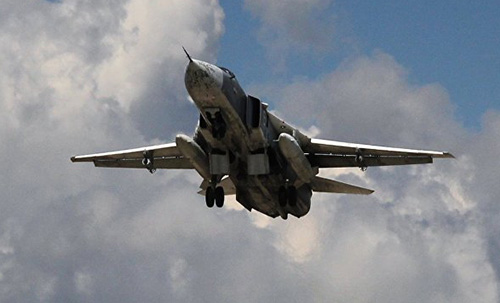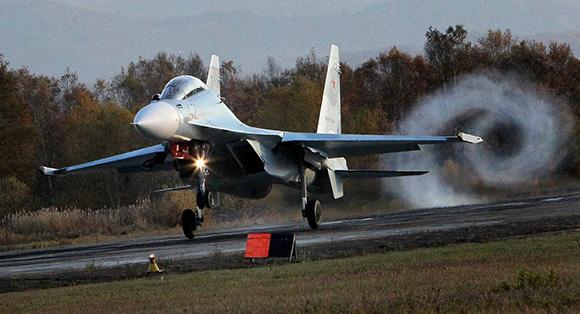The Russians have deployed a Sukhoi Su-30 interceptor fighter force in Syria to escort all aircraft engaged in the Arab Republic. The confirmation comes directly from the spokesman for the Russian Defense Ministry, General Igor Konashenkov.
"Our fighters will escort all Russian Aerospace Force Air Group bombers engaged in Syria".
It should be noted that the Russians, in the official statement, speak of the interceptor fighter and not of its 'M' variant, which also performs the task of precision fighter-bomber. From the Kremlin they speak of escorting bombers, but one wonders against which enemies. They would be worthy opponents against the coalition planes, but certainly not against the Islamic State which, as we know, at most has commercial drones and some helicopters (obviously stolen from loyalist troops). It is clear, therefore, that the new contingent stands as a show of force against NATO and the United States.
The latter, as is known, by withdrawing the USS Theodore Roosevelt from the Persian Gulf, no longer have the 65 fighter aircraft that until last week, participated in the raids in Syria and Iraq (the F-16s in Turkey remain). A move, that of sending Russian interceptor fighters, which will only strengthen the air dominance over the Region.
According to the spokesman for the Ministry of Defense, in the last 24 hours 25 strongholds of the Islamic State have been destroyed near the village of Salma, in the province of Latakia. Between Friday and last Saturday, the Russians carried out 55 sorties for 53 destroyed targets.
"Russian Aerospace Force Air Group in Syria" as of 2015 October XNUMX
The naval base of Tartus, on the Mediterranean coast of Syria is protected by five warships led by the Slava-class missile cruiser, the Moskva. The latter, thanks to its 64 S-300 PMU-1/2 surface-to-air missiles, has effectively imposed one no-fly zone which includes most of Syria, Israel and the southern part of Turkey.
Bassel al-Assad International, an airport 20 km south of Latakia on the Mediterranean coast of Syria connected to the main port of the country, has a force capable of hitting targets on the ground. The Russians have twelve Su-24 Fencer low-flying tactical bombers, twelve Su-25 Frogfoot ground attack and close support aircraft, four advanced fourth-generation Su-30SM fighters and fifteen heavy attack helicopters.

Kamov Ka-52 'Alligators' take off from al-Hmeimim base. The al-Hmaimim base, probably the most fortified by the Russians, has become the main outpost for all attacks conducted by the Su-34 platforms. It should be noted that the presence of fighter-bombers, despite the small number available, was kept hidden until a few days ago. Moscow has fewer than 50 Su-34s in service, but may have eight to twelve in Syria. The air force is supplied by ten tankers. Six to twelve Su-30 interceptor fighters were deployed to defend the bombers.
The airports and naval base of Tartus are protected by three battalions (about 500 men) of marines. The ground force also includes nine third-generation T-90, 35 BTR-82A tanks, various heavy artillery pieces including multiple rocket launchers and 500 troops. Probable the presence of some TOS-1 system. All bases are protected by different ground-to-air systems. The Bassel al-Assad International is also used by the Kremlin for all the reconnaissance and attack missions of the drones deployed in Syrian territory. The defensive perimeter includes the Al-Sanobar military base, seven kilometers north of Latakia and the Istamo storage complex, three kilometers west. Overall, Moscow has between 2000 and 2500 soldiers in Syria.
Certainly the presence, close to the Syrian coasts, of at least one attack submarine. Finally, in the Caspian Sea, the Russians have a multiple missile battery formed by the Dagestan, “Gepard” class frigate and the Buyan class corvettes, Grad Sviyazhsk, Uglich and Veliky Ustyug. The last time Putin asked for authorization to use the armed forces outside the national borders dates back to the first months of 2014 during the Ukraine crisis.
Blitzkrieg or attrition?
Sooner or later, the situation will have to evolve. The arrival of long-range interceptor fighters cannot be seen as game changer of the conflict, but more as a measure to discourage possible airspace intrusions, those possible "unintentional accidents" feared by the White House and the Kremlin.
Considering the current strength deployed by the Russians, it is clear that in the short term, the strategy is working. Raising the morale of the battered Syrian troops, reassured by the Russian bear, never so fit in the last 25 years. Sooner or later, however, we will reach the halfway point, to avoid that "quagmire" (as stated by Obama) in which Putin could find himself. Because beyond advanced fourth generation technology, the Russians cannot defeat the Islamic State from the air. The Americans understood it, the Russians should know too.
That Putin is making the same cyclical mistake as the Americans?
In a few weeks, the Syrian army will have to go on the offensive against its enemies, formed by both "moderate" rebel groups and the Islamic State. But the Russians are now forced to move the board. What we see in Syria is not the synthesis of the Russian army, but a small mirror projection of a modernizing force, still predominantly made up of obsolete equipment and means. Putin has set the deadline for full rearmament of the army at 2020 (likely 2022), but this is still proceeding slowly. Certainly, the Russian strategy did not take into account an American-style war, for a commitment outside the former Soviet domains. Russia, engaged in "small skirmishes" in recent years, finds itself embroiled in a civil war within a country (there could be two if Iraq makes an official request) thousands of kilometers away from its borders. The Russians are hoping to put down the Syrian uprising from the air, but this is more a hope than a realistic view of the ongoing war, for a ground force made up of poorly trained men not to mention aviation. Suffice it to say that Assad's air force does not have aircraft capable of carrying out night missions (this, however, did not prevent the dictator from using planes to attack civilians).
Data in hand, an offensive in the provinces of Hama and Homs could be feasible, but it would require a significant logistical effort. Effort that the Russians have not yet put in place. And behold, then, that Putin may have dusted off history to resolve the Syrian crisis: cause maximum damage from the air by imposing overwhelming air superiority and forcing the parties to surrender. Recall that the Kremlin plans to close the Syrian practice in four months at the latest. The variables, however, are too many. From the age of the equipment (the Su-25/25 platforms were already flying in Afghanistan), to the logistics for a desert context. Suffice it to say that last summer, when air patrols along NATO borders increased, the Russians lost five planes in just two weeks. Finally, we must also consider the reaction of the Russian people, should this blitzkrieg turn into a conflict of attrition.
 (photo: Sputnik)
(photo: Sputnik)












